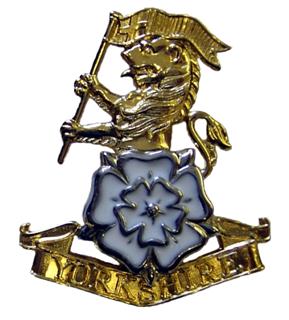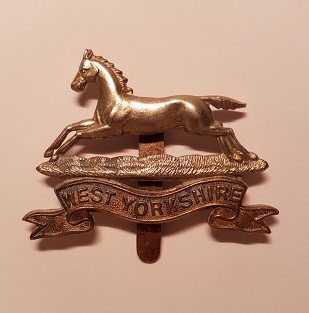History
The regiment was formed in 1999 by the amalgamation of the 3rd Battalion The Prince of Wales's Own Regiment of Yorkshire (Yorkshire Volunteers); 3rd Battalion The Duke of Wellington's Regiment (Yorkshire Volunteers); and the King's Own Yorkshire Yeomanry (Light Infantry) due to the reforms implemented in consequence of the Strategic Defence Review. The regimental headquarters was at Pontefract and the regiment, part of 15 (North East) Brigade, comprised five Rifle Companies: [1] [2]
- Ypres Company (Duke of Wellington's Regiment), at Huddersfield and Keighley
(from C and B Companies, 3rd Battalion, Duke of Wellington's Regiment) - Fontenay Company (Duke of Wellington's Regiment), at Barnsley and Sheffield
(from HQ and A Companies, 3rd Battalion, Duke of Wellington's Regiment) - Quebec Company (Prince of Wales's Own Regiment of Yorkshire), at Hull and Beverley
(from B Company, 3rd Battalion, Prince of Wales's Own Regiment of Yorkshire) - Imphal Company (Prince of Wales's Own Regiment of Yorkshire), at Worsley Barracks, York and Leeds
(from A Company, 3rd Battalion, Prince of Wales's Own Regiment of Yorkshire) - Minden Company (Light Infantry), at Wakefield and Batley
(from HQ and C Squadrons, King's Own Yorkshire Yeomanry)
No new cap badge was created for this regiment: soldiers wore their former regimental cap badge or were badged according to the company they joined. The regimental crest was a combination of the Light Infantry and the Prince of Wales's Own Regiment of Yorkshire cap badges and crest from the Duke of Wellington's Regiment. During the summer of 2004 the regiment adopted a single Tactical Recognition Flash (TRF) of the White Rose of Yorkshire on a black background (this design was previously used by the 49th (West Riding) Infantry Division between the First and early in the Second World War). The official Army abbreviation for the regiment was "E and WRR". [3]
In November 2004, the regiment dispatched a composite company (Normandy Company) to Basra, Iraq as part of 4th Mechanized Brigade of the Multi-National Division (South East) for a 6-month tour-of-duty. [4]
Prior to re-designation
Two months prior to being re-designated as the 4th Battalion of The Yorkshire Regiment, the two Yorkshire companies of the Tyne-Tees Regiment were integrated into the structure of the regiment, and some of the regiment's companies were converted into other units; furthermore, the regimental HQ moved to York. This was to ease the re-designation process in June 2006. After this re-structuring, the regiment's structure was as follows: [2]
- HQ Company (later renamed Waterloo Company), at Worsley Barracks, York and Scarborough
(from Imphal Company, East and West Riding Regiment; and A Company, Tyne-Tees Regiment) - A Company (Prince of Wales's Own Regiment of Yorkshire), at Hull, Beverley, and Leeds
(from Quebec Company, and Leeds Platoon, Imphal Company) - B (Green Howards) Company, at Middlesbrough and Northallerton
(from B Company, Tyne-Tees Regiment) - C Company (Duke of Wellington's Regiment), at Huddersfield and Keighley
(from Ypres Company) - D Company (Duke of Wellington's Regiment), at Barnsley and Sheffield
(from Fontenay Company)
Minden Company was broken up, with the Company HQ forming 299 Parachute Engineer Squadron, and the Doncaster Platoon formed C (Rifles) Company, 5th Battalion, Royal Regiment of Fusiliers. [2]

The Duke of Wellington's Regiment (West Riding) was a line infantry regiment of the British Army, forming part of the King's Division.

The Royal Gloucestershire, Berkshire and Wiltshire Regiment was a short-lived infantry regiment of the British Army.

The Royal Yorkshire Regiment is an infantry regiment of the British Army, created by the amalgamation of three historic regiments in 2006. It lost one battalion as part of the Army 2020 defence review. The regiment's recruitment area covers the ceremonial counties of the East Riding of Yorkshire, North Yorkshire, South Yorkshire and West Yorkshire; areas near Barnsley are recruitment area for the Rifles.

The Prince of Wales's Own Regiment of Yorkshire was an infantry regiment of the British Army, part of the King's Division. It was created in 1958 by the amalgamation of the West Yorkshire Regiment and the East Yorkshire Regiment. After 48 years service, the regiment was amalgamated again, this time with two other Yorkshire regiments. It became the 1st Battalion of the Yorkshire Regiment, with the Green Howards forming the 2nd Battalion and the Duke of Wellington's Regiment forming the 3rd Battalion on 6 June 2006. Following further merges, in 2012, the battalion was redesignated as the new 2nd Battalion (2Yorks).

The West Yorkshire Regiment (Prince of Wales's Own) (14th Foot) was an infantry regiment of the British Army. In 1958 it amalgamated with the East Yorkshire Regiment (15th Foot) to form the Prince of Wales's Own Regiment of Yorkshire which was, on 6 June 2006, amalgamated with the Green Howards and the Duke of Wellington's Regiment (West Riding) to form the Yorkshire Regiment (14th/15th, 19th and 33rd/76th Foot).
The Royal Welsh Regiment was an infantry regiment of the Territorial Army in the United Kingdom. It existed from 1999, until it was re-designated as the 3rd Battalion, The Royal Welsh in 2006.
The Lancastrian and Cumbrian Volunteers was a Territorial Army unit of the British Army.
The 1957 White Paper on Defence was a British white paper issued in March 1957 setting forth the perceived future of the British military. It had profound effects on all aspects of the defence industry but probably the most affected was the British aircraft industry. Duncan Sandys, the recently appointed Minister of Defence, produced the paper. The decisions were influenced by two major factors: the finances of the country and the coming of the missile age.
The Yorkshire Brigade was an administrative brigade formation of the British Army from 1948 to 1968. The brigade administered the regular infantry regiments of Yorkshire, England.

The Home Service Force (HSF) was a Home Guard type force established in the United Kingdom in 1982. Each HSF unit was placed with either a Regular Army or Territorial Army regiment or battalion for administrative purposes and given that formation's title, cap badge and recruited from volunteers aged 18–60 with previous British forces experience. It was introduced to guard key points and installations likely to be the target of enemy special forces and saboteurs, so releasing other units for mobile defence roles. It was stood down in 1992.
The Yorkshire Volunteers was an infantry regiment of the British Territorial Army. The regiment was raised on 1 April 1967 and disbanded on 25 April 1993.

The regimental depot of a regiment is its home base for recruiting and training. It is also where soldiers and officers awaiting discharge or postings are based and where injured soldiers return to full fitness after discharge from hospital before returning to full duty. Normally, a variety of regimental stores will also be kept at the depot. The regimental depot is not the same as the regimental headquarters, though in practice the two will often be co-located in the same place.
In September 1939, the British Army was in process of expanding their anti-aircraft and mobile assets. Among these new changes was the formation of Anti-Aircraft Command which was formed on 1 April 1939, and the 1st Armoured Division formed in 1937. The list below will include the British Army units, colonial units, and those units which were in the process of formation.
The Leeds Rifles was a unit of the 19th century Volunteer Force of the British Army that went on to serve under several different guises in the World Wars of the 20th century. In the First World War, both battalions served as infantry on the Western Front. They were later converted into an anti-aircraft and tank units, and fought in North Africa, Italy, and Burma during the Second World War.

Battlesbury Barracks is a British Army installation in Warminster, Wiltshire, England. It is the permanent base of the Royal Dragoon Guards, serving as armoured cavalry.

Londesborough Barracks is a military installation in Kingston upon Hull, England.
The 3rd Battalion, Yorkshire Volunteers was an infantry battalion of the only full Territorial Army (TA) regiment in Yorkshire. The battalion was formed along with the 2nd Battalion of the same regiment in 1971. However, in 1992 following the end of the Cold War, the 3rd and 4th battalions amalgamated, thus ending the official lineage.
The 4th Battalion, Yorkshire Volunteers was an infantry battalion of Yorkshire's only Territorial Army (TA) regiment, and existed for just around four years before amalgamating with another battalion of the Yorkshire Volunteers.
This page is based on this
Wikipedia article Text is available under the
CC BY-SA 4.0 license; additional terms may apply.
Images, videos and audio are available under their respective licenses.







